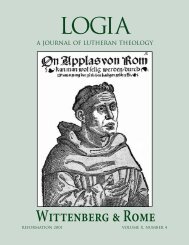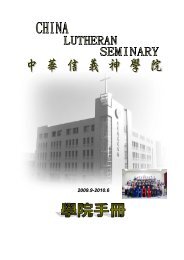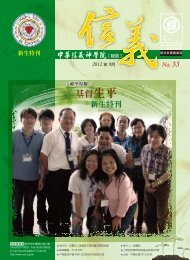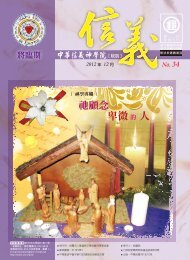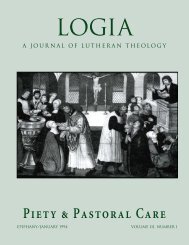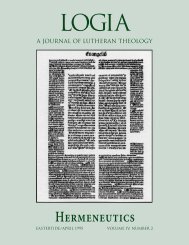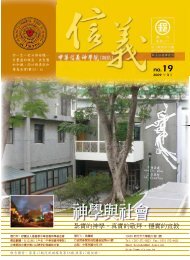05-4 Theology of the..
05-4 Theology of the..
05-4 Theology of the..
Create successful ePaper yourself
Turn your PDF publications into a flip-book with our unique Google optimized e-Paper software.
50 LOGIA<br />
3. Vilmos Vajta, Lu<strong>the</strong>r on Worship (Philadelphia: Muhlenberg Press,<br />
1958); “Creation and Worship,” in Studia Liturgica 2 (1963): 29–33.<br />
4. Peter Brunner, Worship in <strong>the</strong> Name <strong>of</strong> Jesus (St. Louis: Concordia<br />
Publishing House, 1968). Although categorizing <strong>the</strong> second part <strong>of</strong> Brunner’s<br />
work under “<strong>the</strong>ologies from worship,” Fagerberg speaks <strong>of</strong> this<br />
book in most instances as a “<strong>the</strong>ology <strong>of</strong> worship.”<br />
5. Ge<strong>of</strong>frey Wainwright, Doxology—The Praise <strong>of</strong> God in Worship,<br />
Doctrine and Life: A Systematic <strong>Theology</strong> (New York: Oxford University<br />
Press, 1980).<br />
6. Fagerberg, 128, states, “It is within Protestant traditions that one<br />
sees <strong>the</strong> strongest and clearest examples <strong>of</strong> doctrinal control over worship.<br />
... It was <strong>the</strong> Calvinists who most severely reshaped ritual structures<br />
and texts ....” And on page 195, Fagerberg boldly states his major<br />
<strong>the</strong>sis: “This is why lex orandi establishes lex credendi and not vice versa.”<br />
7. Aidan Kavanagh, On Liturgical <strong>Theology</strong> (New York: Pueblo Publishing<br />
Company, 1984).<br />
Timothy Maschke<br />
Concordia University Wisconsin<br />
Mequon, Wisconsin<br />
Worship in Transition: The Liturgical Movement in <strong>the</strong> Twentieth<br />
Century. By John Fenwick and Bryan Spinks. New York: Continuum,<br />
1985. 197 pages.<br />
■ Some people think <strong>the</strong>re has been too much talk about worship<br />
in recent years. O<strong>the</strong>rs thrive on liturgical discourse. Like it<br />
or not, <strong>the</strong> current interest in liturgical <strong>the</strong>ology and practice<br />
will continue. In under two hundred pages, Fenwick and Spinks<br />
show how <strong>the</strong> present level <strong>of</strong> interest in things liturgical is, to a<br />
large extent, <strong>the</strong> result <strong>of</strong> a movement whose beginnings go back<br />
to <strong>the</strong> turn <strong>of</strong> <strong>the</strong> century.<br />
Every denomination has been affected by <strong>the</strong> Liturgical<br />
Movement. Its influence has been worldwide. Its influence has<br />
touched most congregations. Its impact on American<br />
Lu<strong>the</strong>ranism has been pr<strong>of</strong>ound. The authors have done a<br />
remarkable job in surveying <strong>the</strong> vast historical terrain, isolating<br />
<strong>the</strong> major <strong>the</strong>mes, and addressing key issues. Chapter 2 summarizes<br />
<strong>the</strong> primary characteristics <strong>of</strong> <strong>the</strong> movement: “<strong>the</strong><br />
struggle for community” in society and <strong>the</strong> church, <strong>the</strong> new<br />
emphasis on <strong>the</strong> participation <strong>of</strong> <strong>the</strong> laity in <strong>the</strong> liturgy, a<br />
recovery <strong>of</strong> <strong>the</strong> early church as a model, a rediscovery <strong>of</strong> <strong>the</strong><br />
Bible, a rediscovery <strong>of</strong> <strong>the</strong> eucharistic, an emphasis on <strong>the</strong> vernacular<br />
and contemporary language, <strong>the</strong> rediscovery <strong>of</strong> o<strong>the</strong>r<br />
Christian traditions, and an emphasis on proclamation and<br />
social involvement.<br />
Historically <strong>the</strong> Liturgical Movement was a Roman Catholic<br />
movement. Three chapters describe its development through<br />
both its pre- and post-Vatican II phases. The flow went from<br />
Trent to Vatican II, from <strong>the</strong> continent (France-Belgium-Germany-Rome)<br />
to England to North America. The pastoral problems<br />
that gave rise to <strong>the</strong> movement were not unique to Europe<br />
alone. “It is not surprising, <strong>the</strong>refore, that <strong>the</strong> insights <strong>of</strong> this<br />
Catholic movement had parallel stirrings in o<strong>the</strong>r Churches,<br />
and in turn influenced, and <strong>the</strong>n were developed in non-Roman<br />
Catholic ways in o<strong>the</strong>r Churches” (37). Three chapters survey<br />
<strong>the</strong> liturgical movement in <strong>the</strong> Anglican Church and South<br />
India. Any Lu<strong>the</strong>ran pastor with a volume by Lu<strong>the</strong>r Reed or<br />
Gregory Dix on his shelf appreciates <strong>the</strong> influence <strong>the</strong> Anglican<br />
Church has had on <strong>the</strong> Lu<strong>the</strong>ran liturgy. Both Fenwick and<br />
Spinks are priests in <strong>the</strong> Church <strong>of</strong> England. Some Lu<strong>the</strong>rans<br />
will be familiar with Bryan Spinks’s excellent book Lu<strong>the</strong>r’s<br />
Liturgical Criteria and His Reform <strong>of</strong> <strong>the</strong> Canon <strong>of</strong> <strong>the</strong> Mass<br />
(Grove Liturgical Studies 30). Every Lu<strong>the</strong>ran pastor should be<br />
familiar with it.<br />
Chapter 10 looks at how <strong>the</strong> Eastern Orthodox churches provided<br />
<strong>the</strong> inspiration for much <strong>of</strong> <strong>the</strong> reforming work <strong>of</strong> <strong>the</strong><br />
Liturgical Movement. According to Fenwick and Spinks, such<br />
insights as worship as <strong>the</strong> “collaboration” <strong>of</strong> <strong>the</strong> entire community;<br />
<strong>the</strong> shift to an “emphasis upon <strong>the</strong> resurrection and glory<br />
ra<strong>the</strong>r than upon <strong>the</strong> piety <strong>of</strong> <strong>the</strong> suffering <strong>of</strong> Christ <strong>of</strong> <strong>the</strong> west,”<br />
<strong>the</strong> epiclesis, <strong>the</strong> passing <strong>of</strong> <strong>the</strong> peace, <strong>the</strong> anaphora <strong>of</strong> St. Basil,<br />
reconsideration <strong>of</strong> infant communion, and o<strong>the</strong>r emphases are <strong>of</strong><br />
Eastern origin. They write, “It is extraordinary how many<br />
involved in <strong>the</strong> Liturgical movement owe at least some <strong>of</strong> <strong>the</strong>ir<br />
thinking to Eastern contacts” (97).<br />
Chapter 12, “Behind <strong>the</strong> Consensus on <strong>the</strong> Eucharist,”<br />
begins, “A comparison <strong>of</strong> <strong>the</strong> majority <strong>of</strong> new eucharistic liturgies<br />
reveals that <strong>the</strong> Liturgical Movement has left behind a<br />
remarkable degree <strong>of</strong> consensus on <strong>the</strong> structure and content<br />
<strong>of</strong> <strong>the</strong> eucharistic liturgy” (115). Again, “The amount <strong>of</strong> crossfertilization<br />
that has taken place between <strong>the</strong> Churches has<br />
blurred <strong>the</strong> distinction between <strong>the</strong>ir rite”. ... In one sense, to<br />
have read one new rite is to have read <strong>the</strong>m all” (116). Rome<br />
followed <strong>the</strong> path <strong>of</strong> streamlining and restoration in <strong>the</strong> reform<br />
<strong>of</strong> <strong>the</strong> liturgy. The Anglican church followed <strong>the</strong> path <strong>of</strong> “radical<br />
reshaping” (117), which centered on Gregory Dix’s fouraction<br />
shape. “Dix’s <strong>the</strong>ory has been influential in <strong>the</strong> Lu<strong>the</strong>ran<br />
Book <strong>of</strong> Worship as well as in practically all o<strong>the</strong>r Anglican revisions”<br />
(128). This is a very important observation in light <strong>of</strong> <strong>the</strong><br />
remark in chapter 5 that “Dix’s arguments and evidence are<br />
flawed” (51). The remark is footnoted with a reference to an<br />
article by Bryan Spinks titled “Mis-Shapen: Gregory Dix and<br />
<strong>the</strong> Four-Action Shape <strong>of</strong> Liturgy” (Lu<strong>the</strong>ran Quarterly 4 [1990]:<br />
161–177).<br />
This book will undoubtedly be included on <strong>the</strong> reading list <strong>of</strong><br />
liturgics courses at many seminaries. The chapters are brief and<br />
clearly written. Many chapters will lend <strong>the</strong>mselves nicely as topics<br />
for monthly pastoral conferences: chapter 11 looks at <strong>the</strong> relationship<br />
between <strong>the</strong> Charismatic Movement and <strong>the</strong> Liturgical<br />
Movement; chapter 13 is titled “The Changing Face <strong>of</strong> Baptism<br />
and Confirmation”; chapter 14 raises some very important and<br />
insightful questions on <strong>the</strong> language <strong>of</strong> worship; and chapter 15<br />
looks at inculturation.<br />
Chapter 16, “Opposition and Reaction,” <strong>of</strong>fers valuable<br />
insight and analysis. The chapter begins, “Almost from its very<br />
beginnings <strong>the</strong> Liturgical Movement has provoked opposition.”<br />
The new language and re-ordered church buildings produced a<br />
“sense <strong>of</strong> loss,” “bewilderment,” and “bereavement” for many<br />
people. In <strong>the</strong> section titled “Loss <strong>of</strong> doctrinal purity” <strong>the</strong><br />
authors write, “Liturgy expresses what Christians believe. To<br />
change <strong>the</strong> liturgy <strong>the</strong>refore runs <strong>the</strong> risk <strong>of</strong> changing doctrine—or<br />
at least those doctrines which worshipers regularly<br />
hear and absorb and which become part <strong>of</strong> <strong>the</strong>ir Christian<br />
identity” (169). Fenwick and Spinks raise a very important<br />
question: “How much <strong>of</strong> <strong>the</strong> doctrinal content <strong>of</strong> a liturgy






